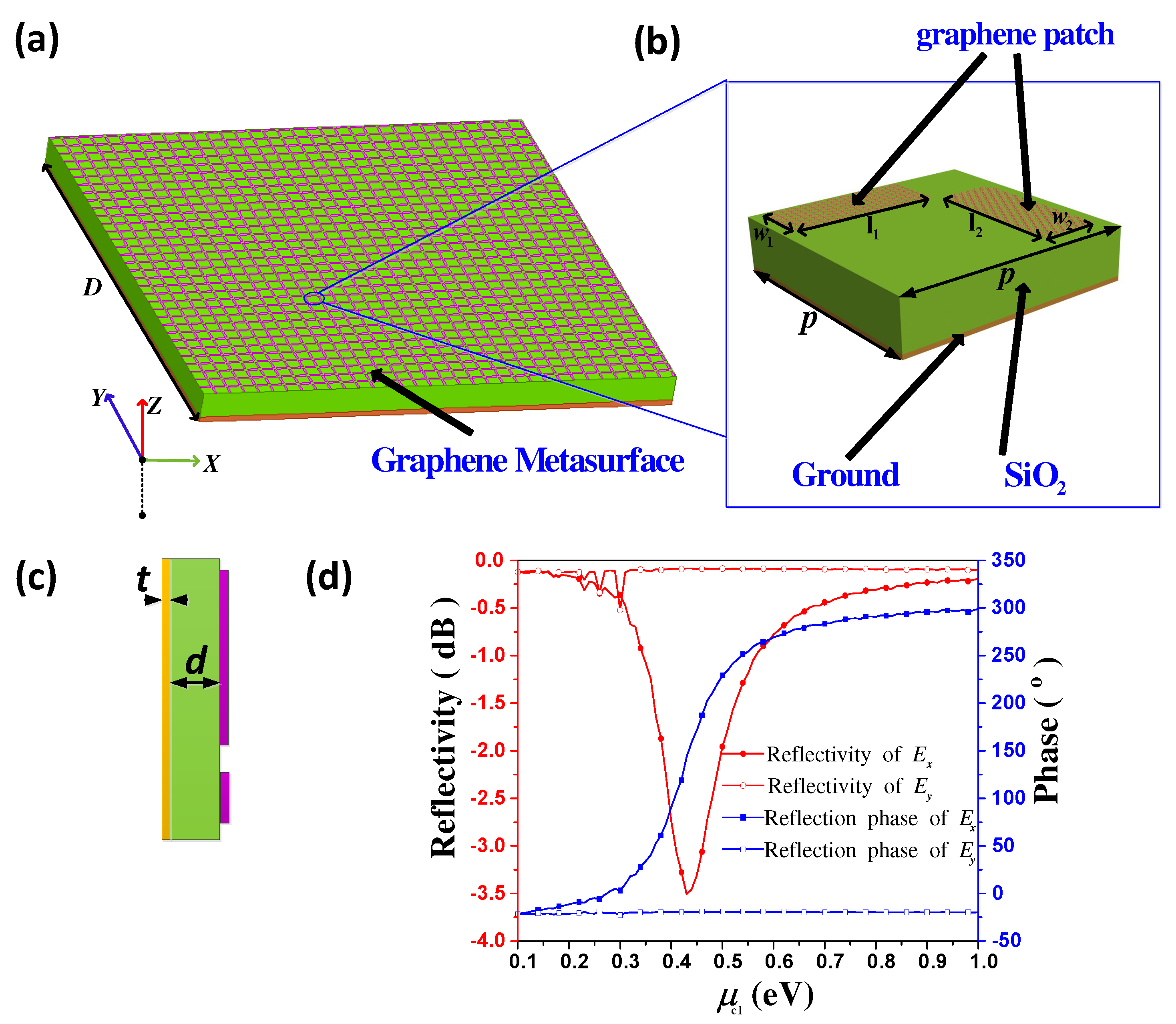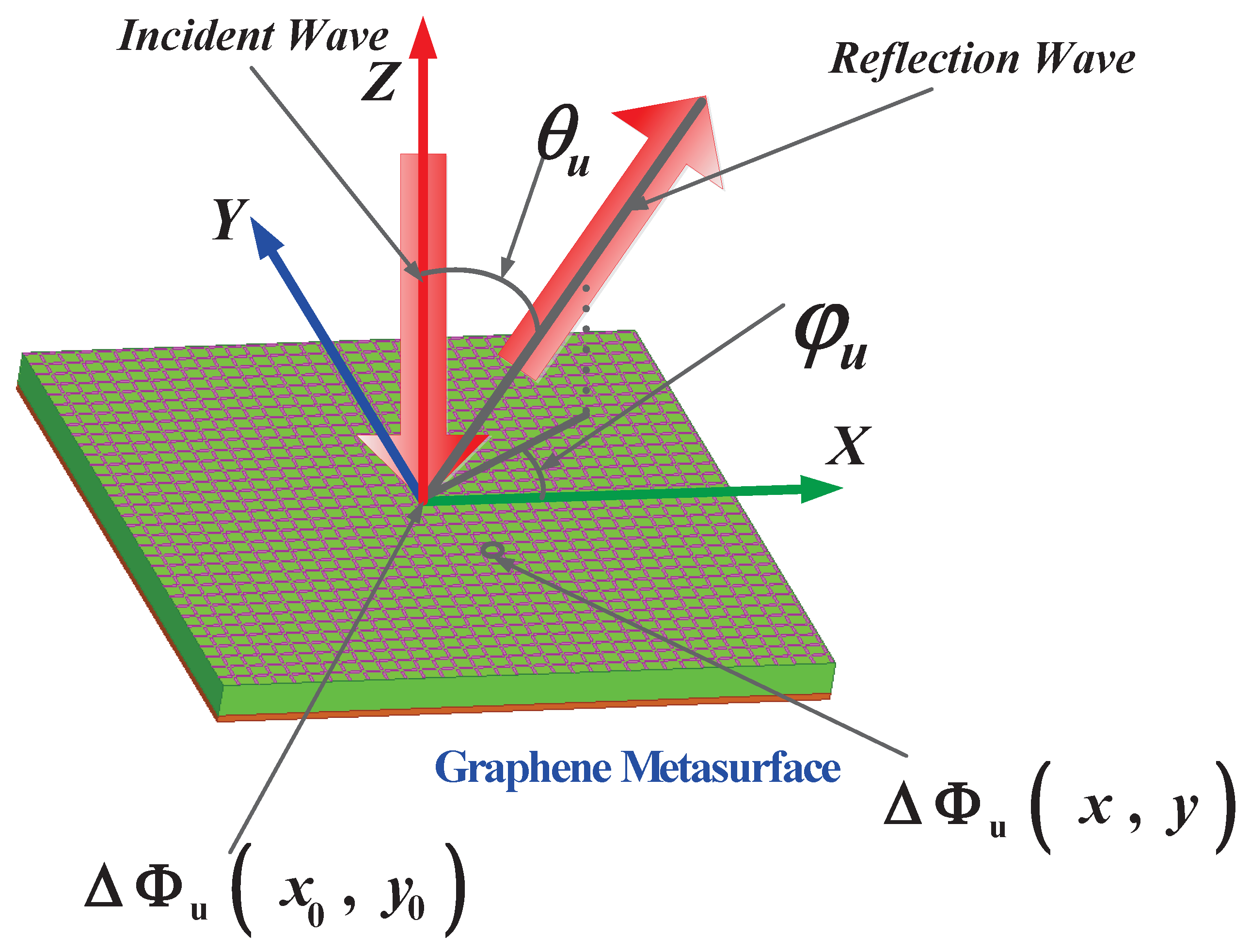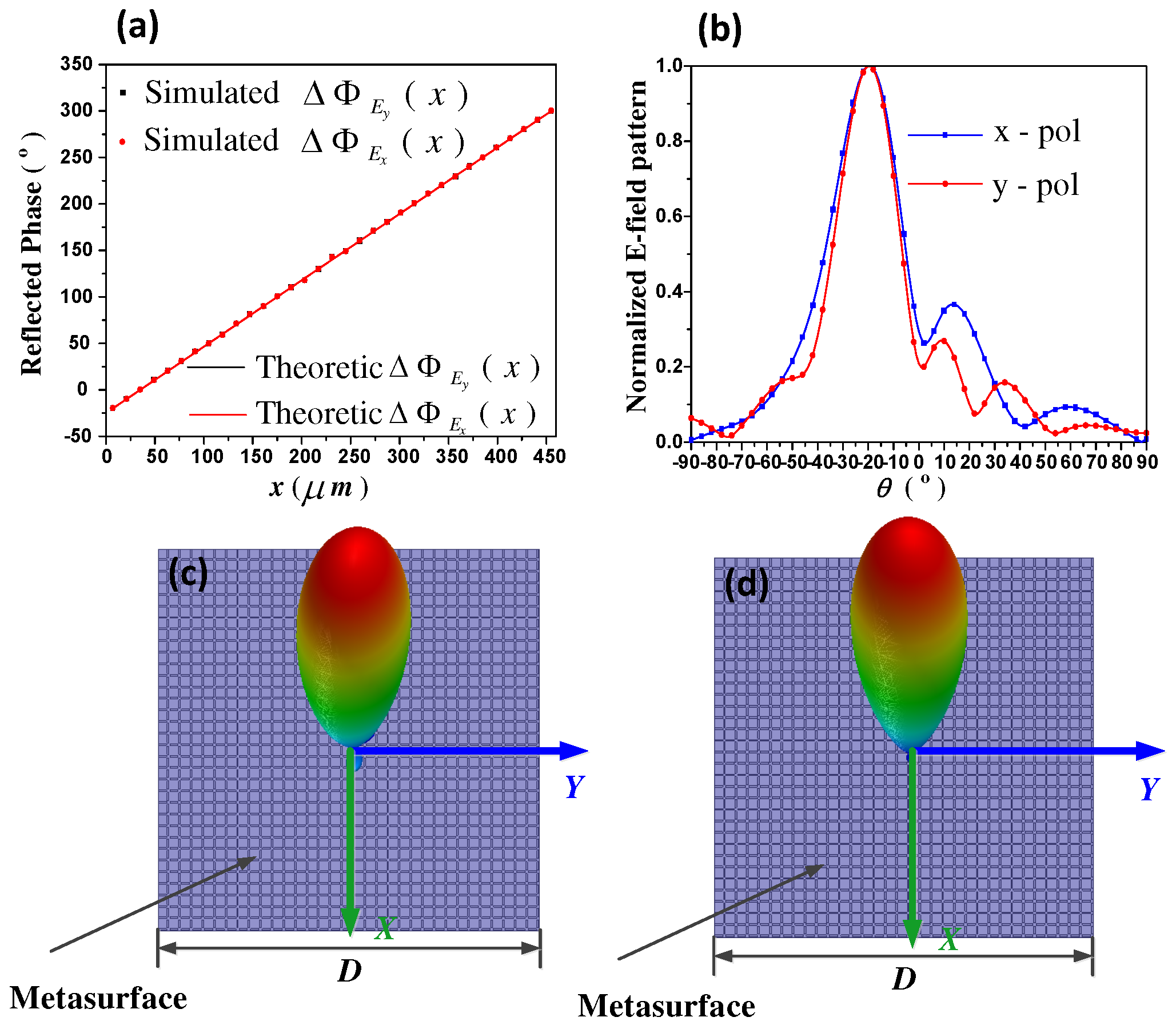Independent Manipulating of Orthogonal-Polarization Terahertz Waves Using A Reconfigurable Graphene-Based Metasurface
Abstract
:1. Introduction
2. Properties of Graphene-Based Unit-Cell
3. Design and Numerical Results of Proposed Reconfigurable Metasurface
3.1. Graphene-Based Metasurface for Beam Splitting
3.2. Graphene-Based Metasurface for Arbitrarily Linearly Polarized Beam Deflecting
3.3. Graphene-Based Metasurface for Linearly-to-Circularly Polarized Converting
4. Conclusions
Author Contributions
Funding
Conflicts of Interest
References
- Zheludev, N.I.; Kivshar, Y.S. From metamaterials to metadevices. Nat. Mater. 2012, 11, 917–924. [Google Scholar] [CrossRef] [PubMed]
- Puscasu, I.; Schaich, W.L. Narrow-band, tunable infrared emission from arrays of microstrip patches. Appl. Phys. Lett. 2008, 92, 233102. [Google Scholar] [CrossRef]
- Liu, X.; Starr, T.; Starr, A.F.; Padilla, W.J. Infrared spatial and frequency selective metamaterial with near-unity absorbance. Phys. Rev. Lett. 2010, 104, 207403. [Google Scholar] [CrossRef] [PubMed]
- Ogawa, S.; Kimata, M. Metal-insulator-metal-based plasmonic metamaterial absorbers at visible and infrared wavelengths: A review. Materials 2018, 11, 458. [Google Scholar] [CrossRef] [PubMed]
- Yao, Y.; Shankar, R.; Kats, M.A.; Song, Y.; Kong, J.; Loncar, M.; Capasso, F. Electrically tunable metasurface perfect absorbers for ultrathin mid-infrared optical modulators. Nano Lett. 2014, 14, 6526–6532. [Google Scholar] [CrossRef] [PubMed]
- Yu, N.; Genevet, P.; Kats, M.A.; Aieta, F.; Tetienne, J.P.; Capasso, F.; Gaburro, Z. Light propagation with phase discontinuities: generalized laws of reflection and refraction. Science 2011, 334, 333–337. [Google Scholar] [CrossRef] [PubMed]
- Sun, S.; Yang, K.Y.; Wang, C.M.; Juan, T.K.; Chen, W.T.; Liao, C.Y.; He, Q.; Xiao, S.; Kung, W.T.; Guo, G.Y. High-efficiency broadband anomalous reflection by gradient meta-surfaces. Nano Lett. 2012, 12, 6223–6229. [Google Scholar] [CrossRef] [PubMed]
- Liu, Z.; Chen, S.; Li, J.; Cheng, H.; Li, Z.; Liu, W.; Yu, P.; Xia, J.; Tian, J. Fully interferometric controllable anomalous refraction efficiency using cross modulation with plasmonic metasurfaces. Opt. Lett. 2014, 39, 6763–6766. [Google Scholar] [CrossRef] [PubMed]
- Pors, A.; Nielsen, M.G.; Eriksen, R.L.; Bozhevolnyi, S.I. Broadband focusing flat mirrors based on plasmonic gradient metasurfaces. Nano Lett. 2013, 13, 829–834. [Google Scholar] [CrossRef] [PubMed]
- Cai, T.; Wang, G.M.; Zhang, X.F.; Liang, J.G.; Zhuang, Y.Q.; Liu, D.; Xu, H.X. Ultra-thin polarization beam splitter using 2-D transmissive phase gradient metasurface. IEEE Trans. Antennas Propag. 2015, 63, 5629–5636. [Google Scholar] [CrossRef]
- Liu, W.; Chen, S.; Li, Z.; Cheng, H.; Yu, P.; Li, J.; Tian, J. Realization of broadband cross-polarization conversion in transmission mode in the terahertz region using a single-layer metasurface. Opt. Lett. 2015, 40, 3185–3188. [Google Scholar] [CrossRef] [PubMed]
- Jia, Y.; Liu, Y.; Zhang, W.; Gong, S. Ultra-wideband and high-efficiency polarization rotator based on metasurface. Appl. Phys. Lett. 2016, 109, 407. [Google Scholar] [CrossRef]
- Zhang, W.; Zhu, W.M.; Chia, E.E.M.; Shen, Z.X.; Cai, H.; Gu, Y.D.; Ser, W.; Liu, A.Q. A pseudo-planar metasurface for a polarization rotator. Opt. Express 2014, 22, 10446. [Google Scholar] [CrossRef] [PubMed]
- Chen, M.L.N.; Jiang, L.J.; Sha, W.E.I. Ultrathin complementary metasurface for orbital angular momentum generation at microwave frequencies. IEEE Trans. Antennas Propag. 2017, 65, 396–400. [Google Scholar] [CrossRef]
- Bingham, C.; Montoya, J.; Suen, J.Y.; Fan, K.; Sriram, S.; Stenger, V.; Padilla, W.J. Multifunctional metamaterial pyroelectric infrared detectors. Optica 2017, 4, 276. [Google Scholar]
- La, S.L.; Vegni, L. Electromagnetic nanoparticles for sensing and medical diagnostic applications. Materials 2018, 11, 603. [Google Scholar]
- Minatti, G.; Maci, S.; Vita, P.D.; Freni, A.; Sabbadini, M. A circularly-polarized isoflux antenna based on anisotropic metasurface. IEEE Trans. Antennas Propag. 2012, 60, 4998–5009. [Google Scholar] [CrossRef]
- Yang, Q.; Gu, J.; Wang, D.; Zhang, X.; Tian, Z.; Ouyang, C.; Singh, R.; Han, J.; Zhang, W. Efficient flat metasurface lens for terahertz imaging. Opt. Express 2014, 22, 25931–25939. [Google Scholar] [CrossRef] [PubMed]
- Yang, Y.; Jing, L.; Zheng, B.; Hao, R.; Yin, W.; Li, E.; Soukoulis, C.M.; Chen, H. Full-polarization 3D metasurface cloak with preserved amplitude and phase. Adv. Mater. 2016, 28, 6866–6871. [Google Scholar] [CrossRef] [PubMed]
- Novoselov, K.S.; Geim, A.K.; Morozov, S.V.; Jiang, D.; Zhang, Y.; Dubonos, S.V.; Grigorieva, I.V.; Firsov, A.A. Electric field effect in atomically thin carbon films. Science 2004, 306, 666–669. [Google Scholar] [CrossRef] [PubMed]
- Wang, F.; Zhang, Y.; Tian, C.; Girit, C.; Zettl, A.; Crommie, M.; Shen, Y.R. Gate-variable optical transitions in graphene. Science 2008, 320, 206–209. [Google Scholar] [CrossRef] [PubMed]
- Vakil, A.; Engheta, N. Transformation optics using graphene. Science 2011, 332, 1291–1294. [Google Scholar] [CrossRef] [PubMed]
- Carrasco, E.; Perruisseau-Carrier, J. Reflectarray antenna at terahertz using graphene. IEEE Antennas Wirel. Propag. Lett. 2013, 12, 253–256. [Google Scholar] [CrossRef]
- Li, Z.; Yao, K.; Xia, F.; Shen, S.; Tian, J.; Liu, Y. Graphene plasmonic metasurfaces to steer infrared light. Sci. Rep. 2015, 5, 12423. [Google Scholar] [CrossRef] [PubMed]
- Ma, W.; Huang, Z.; Bai, X.; Zhan, P.; Liu, Y. Dual-band light focusing using stacked graphene metasurfaces. ACS Photonics 2017, 4, 1770–1775. [Google Scholar] [CrossRef]
- Huang, L.; Jing, L.; Liu, T.; Hong, W.; Liu, W.; Ling, Y.; Wang, Z. Polarization-switchable and wavelength-controllable multi-functional metasurface for focusing and surface-plasmon-polariton wave excitation. Opt. Express 2017, 25, 29812. [Google Scholar]
- Sherrott, M.C.; Hon, P.W.C.; Fountaine, K.T.; Garcia, J.C.; Ponti, S.M.; Brar, V.W.; Sweatlock, L.A.; Atwater, H.A. Experimental demonstration of >230 phase modulation in gate-tunable graphene–gold reconfigurable mid-infrared metasurfaces. Nano Lett. 2017, 17, 3027–3034. [Google Scholar] [CrossRef] [PubMed]
- Peng, G.H.; Chi, Y.C.; Lin, G.R. DWDM channel spacing tunable optical TDM carrier from a mode-locked weak-resonant-cavity Fabry-Perot laser diode based fiber ring. Opt. Express 2008, 16, 13405–13413. [Google Scholar] [CrossRef] [PubMed]
- Deng, L.; Wu, Y.; Zhang, C.; Hong, W.; Peng, B.; Zhu, J.; Li, S. Manipulating of different-polarized reflected waves with graphene-based plasmonic metasurfaces in terahertz regime. Sci. Rep. 2017, 7, 10558. [Google Scholar] [CrossRef] [PubMed]
- Padooru, Y.R.; Yakovlev, A.B.; Kaipa, C.S.R.; Hanson, G.W.; Medina, F.; Mesa, F.; Glisson, A.W. New absorbing boundary conditions and analytical model for multilayered mushroom-type metamaterials: applications to wideband absorbers. IEEE Trans. Antennas Propag. 2012, 60, 5727–5742. [Google Scholar] [CrossRef]
- Guo, F.; Xia, L.; Yang, T.; Xu, R. A novel metamaterial transmission line with adjustable left-handed elements and its application to H-plane filter. IEEE Microw. Wirel. Compon. Lett. 2018, 28, 774–776. [Google Scholar] [CrossRef]
- Sihvola, A. Electromagnetic Mixing Formulas and Applications; Institution of Electrical Engineers: British; UK, 1999; pp. 36–37. [Google Scholar]
- Hanson, G.W. Dyadic green’s functions and guided surface waves for a surface conductivity model of graphene. J. Appl. Phys. 2008, 103, 19912. [Google Scholar] [CrossRef]
- Huang, J.; Encinar, J. Antenna Analysis Techniques; John Wiley and Sons Inc.: Hoboken, NJ, USA, 2008; pp. 27–78. [Google Scholar]
- Raether, H.R. Surface Plasmons on Smooth and Rough Surface and Gratings; Springer: Berlin, Germany, 1988; pp. 1–133. [Google Scholar]
- Mittleman, D.M. Frontiers in terahertz sources and plasmonics. Nat. Photonics 2013, 7, 666–669. [Google Scholar] [CrossRef]
- Liu, Y.; Hao, Y.; Li, K.; Gong, S. Radar cross section reduction of a microstrip antenna based on polarization conversion metamaterial. IEEE Antennas Wirel. Propag. Lett. 2016, 15, 80–83. [Google Scholar] [CrossRef]
- Zeng, S.; Sreekanth, K.V.; Shang, J.; Yu, T.; Chen, C.K.; Yin, F.; Baillargeat, D.; Coquet, P.; Ho, H.P.; Kabashin, A.V.; et al. Graphene–gold metasurface architectures for ultrasensitive plasmonic biosensing. Adv. Mater. 2015, 28, 6163–6169. [Google Scholar] [CrossRef] [PubMed]
- Geim, A.; Novoselov, K.; Schedin, F.; Morozov, S.; Jiang, D.; Hill, E. Detection of individual gas molecules absorbed on graphene. Nat. Mater. 2007, 6, 652–655. [Google Scholar]
- Shaltout, A.M.; Kim, J.; Boltasseva, A.; Shalaev, V.M.; Kildishev, A.V. Ultrathin and multicolour optical cavities with embedded metasurfaces. Nat. Commun. 2018, 9, 2673. [Google Scholar] [CrossRef] [PubMed]
- Carrasco, E.; Tamagnone, M.; Perruisseau-Carrier, J. Tunable graphene reflective cells for thz reflectarrays and generalized law of reflection. Appl. Phys. Lett. 2013, 102, 183–947. [Google Scholar] [CrossRef]






© 2018 by the authors. Licensee MDPI, Basel, Switzerland. This article is an open access article distributed under the terms and conditions of the Creative Commons Attribution (CC BY) license (http://creativecommons.org/licenses/by/4.0/).
Share and Cite
Deng, L.; Zhang, Y.; Zhu, J.; Qu, M.; Wang, L.; Zhang, C. Independent Manipulating of Orthogonal-Polarization Terahertz Waves Using A Reconfigurable Graphene-Based Metasurface. Materials 2018, 11, 1817. https://doi.org/10.3390/ma11101817
Deng L, Zhang Y, Zhu J, Qu M, Wang L, Zhang C. Independent Manipulating of Orthogonal-Polarization Terahertz Waves Using A Reconfigurable Graphene-Based Metasurface. Materials. 2018; 11(10):1817. https://doi.org/10.3390/ma11101817
Chicago/Turabian StyleDeng, Li, Yuanyuan Zhang, Jianfeng Zhu, Meijun Qu, Ling Wang, and Chen Zhang. 2018. "Independent Manipulating of Orthogonal-Polarization Terahertz Waves Using A Reconfigurable Graphene-Based Metasurface" Materials 11, no. 10: 1817. https://doi.org/10.3390/ma11101817





